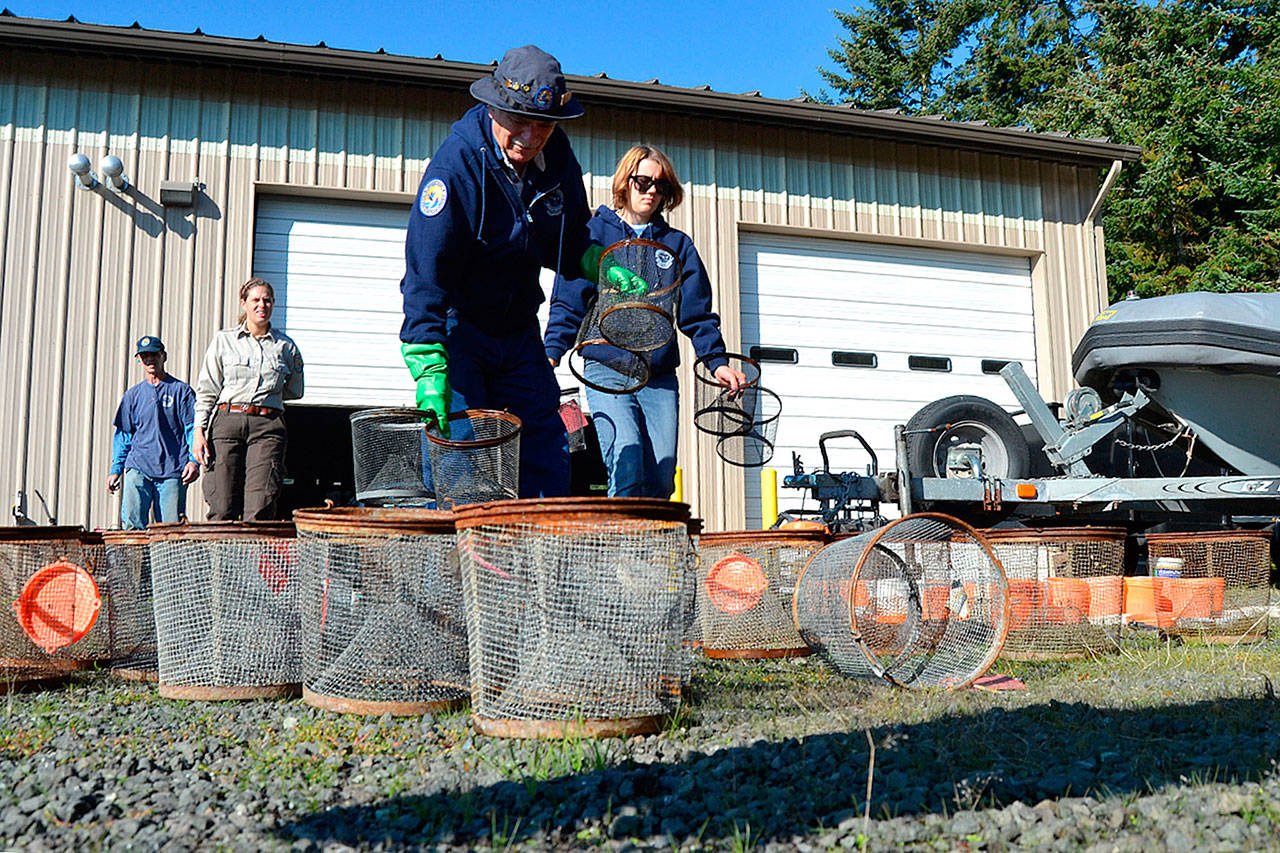Researchers encourage residents who spot a European green crab to snap pictures of the crab(s) and send them to the Crab Team at crabteam@uw.edu for identification so that resource managers can respond to the scene. For more resources on the green crab, visit wsg.washington.edu/crabteam and https://wdfw.wa.gov/ais.
Resource managers at Dungeness’ Washington Maritime National Wildlife Refuge say their hunt for the invasive European green crab may have improved after one season.
Lorenz Sollmann, deputy project leader at the refuge, said they caught 69 green crab on the Dungeness Spit from April-Oct. 7, with all but four of those found on Graveyard Spit. That’s down from 96 last year during approximately the same time span.
“Right now, we’re happy to see the numbers go down, which is a positive direction,” Sollmann said on Oct. 11, when staff and volunteers cleaned and stored traps for the season.
Their effort isn’t a new venture in Dungeness. Staff and volunteers began trapping in 2001 because green crab as a preventative measure when the species was found along the Washington state coast. Distinct for their five spines on each side of their eyes, green crabs threaten native species like the Dungeness crab by out-competing for habitat, Sollmann said.
Green crabs were first captured in Dungeness last spring and have now been trapped across the North Olympic Peninsula, including one found on June 15 across the water at Dungeness Landing.
Crab Team program manager Dr. Emily Grason, a marine ecologist with Washington Sea Grant, said trapping in small numbers can prevent the crabs from spreading because female green crabs can release hundreds of thousands of larvae per brood at least once a year and spread far through currents.
Grason previously reported that testing showed Dungeness’ green crabs likely came from from a coastal population in Washington state, Canada, Oregon or California.
Juliana Merluccio, biological science technician at the refuge, said their traps last caught a green crab on Sept. 21 and for the season they placed 2,677 traps.
Last year, resource managers placed 127 traps at their peak, but Merluccio said they wanted a more manageable and consistent number this year so they averaged 45 traps and peaked at 53.
She said it takes about three-and-a-half hours to check traps and slightly less to set them.
Sollmann said they caught 47 males and 22 females ranging from 33 millimeters-87 millimeters this season.
“The size average did creep up from last year, but nothing indicates they’ve been here a long time,” he said.
While other monitoring sites stop trapping in September, Sollmann said they went into October to learn more since one green crab was caught last October.
Resources managers say green crabs typically go to deeper water in the winter because of tidal shifts, cooling temperatures and behavioral reasons.
Sollmann said this season they experimented with prospect trapping sites, which led them to find four green crab in the Dungeness Spit’s base lagoon.
They’ll continue to do monthly monitoring at three sites in conjunction with Washington Sea Grant’s Crab Team, too.
Support the effort
Merluccio said a devoted team of 27 volunteers helped with monitoring efforts this season, including those who place and pull traps, cut bait, providee transportation volunteers and more.
“We wouldn’t be able to do it without our volunteers,” she said. “They’d probably help year-round if we needed it.”
Bob Anundson just finished his second season helping trap green crab following his wife Gail’s lead to volunteer at the refuge.
“I think it’s important work,” he said. “(Sollmann) gave us a picture of where (the green crab are) going and what (resource managers are) hoping to do. It’s given us some hope to mitigate what we’ve got.”
Anundson plans to return for a third season because he said he feels he’s making a difference.
While trapping this year, Anundson said he finally found a green crab. But, he noted, “It was also sad, because the objective is not to find one.”
Training potential volunteers like Anundson typically happens in March, Sollmann said. Contact the Dungeness Wildlife Refuge, 554 Voice of America Road, at 360-457-8451 for more about volunteering.
Around Washington
Dungeness was the last site to finish official trapping on the North Olympic Peninsula after resource managers found new areas with European green crab.
In Jefferson County, a green crab was found on Sept. 8 at Kala Point Lagoon during routine monthly trap sampling as part of the Crab Team’s early detection network. Intense trapping led by Washington Department of Fish and Wildlife staff led to a second green crab to be trapped in Scow Bay between Indian and Marrowstone Islands.
After catching 34 green crabs in a short span last season in Neah Bay, resource managers through Makah Fisheries Management and community partners captured 1,030 this year in the Wa’atch River and Tsoo-Yess River.
Adrianne Akmajian, marine ecologist with Makah Fisheries Management, said she may do some exploratory trapping in the winter because their numbers were so high.
Along the Salish Sea, volunteers found green crab in June on Whidbey Island’s Lagoon Point, two at Westcott Bay and a molt in Fidalgo Bay on San Juan Island.
Reach Matthew Nash at mnash@sequimgazette.com.



